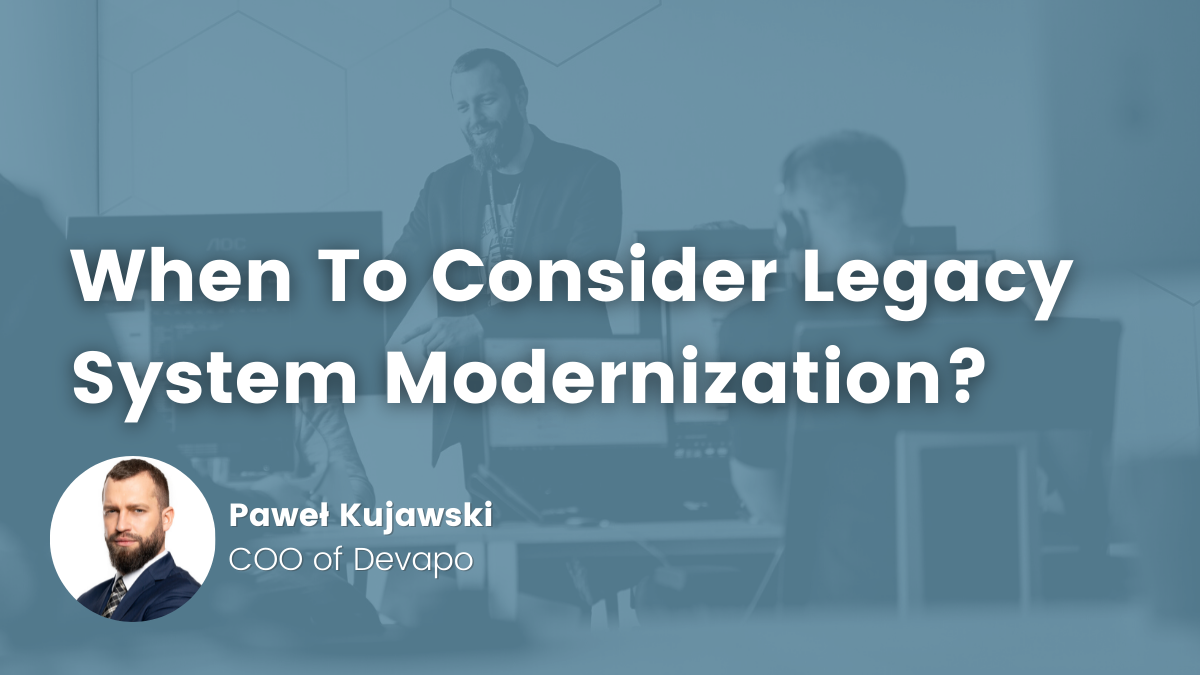- Jakub Kłapyta
- Read in 4 min.
Efficient management and orchestration of product orders across multiple telecommunications operators is essential for seamless operations in the telecom industry. Leveraging the TM Forum OpenAPI standard, we can enable streamlined communication and coordination between diverse network infrastructures. By establishing a universal framework, we can optimize order processing, enhance interoperability, and foster innovation, ultimately benefiting both operators and service providers alike.
TM Forum OpenAPI
TM Forum OpenAPI is a set of standardized Application Programming Interfaces (APIs) developed by TM Forum. These APIs are designed to facilitate integration between the information systems of telecommunications operators and service providers. Through a standardized interface. TM Forum OpenAPI enables effective data exchange and management of business processes.
TM Forum processes used by Devapo in projects
At Devapo we are engaged member of TM Forum, providing dedicated support to our telecommunications clients. Our primary focus is on increasing efficiency within the wholesale sector. Using TM Forum’s various processes, we work diligently to optimize operations and support seamless communication between network operators. Here are some of the processes we use in developing solutions.
- Geographic Address Validation. It verifies the accuracy of addresses within telecommunication systems, crucial for services such as telecommunication service installations or customer support.
- Search Time Slot. This process enables customers to browse available time slots for scheduling appointments with telecommunication service providers. Thanks to that it facilitating activities such as installations, repairs, or consultations.
- Appointment. Process involves scheduling and confirming specific time slots for telecommunication service-related activities, ensuring efficient resource allocation and customer convenience.
- Party Validation. Helps verifies the identity and credentials of customers, suppliers, and other entities involved in telecommunication transactions, ensuring data accuracy and transaction security.
- Product Offering Qualification. It evaluates the availability and suitability of telecommunication services offered, aligning them with customer requirements and preferences.
- Product Order. Process encompasses the submission and processing of orders for telecommunication services by customers and operators, ensuring completeness, accuracy, and timely fulfillment.
- Product Catalog. Serves as a centralized repository of information on offered telecommunication services, including descriptions, prices, contract terms, etc., enabling customers to select appropriate products.
- Product Inventory Management. Involves tracking the availability, location, and status of physical telecommunication resources, such as lines, network devices, or bandwidth capacities.
Standard process for product orders
One of the projects we performed at Devapo for our telco client was creation of platform for managing communication between multiple CPS to help them overcome issues connected to wholesale. We have discovered a faster way to process product orders leveraging TM Forum. Let’s see the comparison of two processes.
Step 1
Input of Customer Address Data and Address Validation: The customer enters their address details into the system, initiating an address validation process. They await the validation outcome to ensure accuracy and suitability for service provision.
Step 2
This is an optional point that can be flexibly initiated at any point during the process, ensuring convenience and adaptability to the customer’s needs.
Search for Available Appointment Slots and Confirmation: The system searches for available appointment slots based on the customer’s preferences and schedule. The customer awaits the confirmation of the appointment booking.
Step 3
This step follows the completion of the previous step. If the preceding step was performed, it becomes the subsequent action.
Reservation of a Specific Time Slot for Appointment: Upon selection of a suitable time slot, the system reserves it for the customer’s appointment, ensuring efficient resource allocation and timely service provision.
Step 4
Customer Data Validation: The system validates the customer’s data to ensure accuracy and compliance with regulatory requirements. The customer awaits the validation outcome before proceeding.
Step 5
Identification and Proper Matching of Products: Based on the telecommunications operator available at the specified address, the system identifies and matches appropriate products to meet the customer’s needs.
Step 6
Product Qualification Process Based on Operator’s Offerings: The system conducts product qualification based on the offerings of the telecommunications operator at the specified address. The customer awaits the qualification outcome to proceed.
Step 7
Commencement of Order Fulfillment: Upon successful validation of customer data and product qualification, the order fulfillment process begins, based on provided products and appointment, initiating the provisioning of the requested services.
Improved process for orchestration and product mapping
Step 1
This is a conditional step, necessary if an appointment needs to be scheduled. However, it can be executed flexibly at any point during the process, according to the user’s needs.
Input of Address Data Along with Date Range and Receipt of Available Appointment List: The customer enters their address details along with the preferred date range into the system. Subsequently, they receive a list of available appointment slots.
Step 2
The following step, performed only if the first one is carried out.
Booking of a Specific Appointment: The customer selects a specific appointment slot from the provided list, initiating the booking process for the chosen time.
Step 3
It is a mandatory step, however, in cases where an appointment was not required, users will be prompted to provide their address details in this step. Address validation will not be immediately triggered. Instead, it will occur as part of the orchestration process, allowing for a seamless flow without waiting for validation feedback at this stage.
Provision of Customer Data Along with Order Information Based on Universal Service Provider Products:
The customer provides their personal information along with the required order details and appointment, considering the universal products offered by the service provider. Validation will be carried out automatically.
Orchestration and product mapping in details
In this section, I will elucidate each of the three steps of order fulfillment utilizing an orchestrator and product mapper:
- Input of Address Data Along with Date Range and Receipt of Available Appointment List: In this process, the user is relieved of the need to separately submit address data and await validation results. Instead, they simply input the desired time frame along with the address details, prompting the system to conduct address validation. Subsequently, the system retrieves and presents available appointment slots. If the address is not found in the operator’s database, the system notifies the user of the error.
- Booking of a Specific Appointment: This step remains unchanged in both the standard process and the process employing an orchestrator. The user selects their preferred appointment slot and proceeds to reserve it.

Provision of Customer Data Along with Order Information Based on Universal Service Provider Products
In the standard process, the user must complete several steps, including entering customer data, awaiting validation, adapting to the operator’s product offerings based on their product catalog, and conducting qualification on required products before commencing order fulfillment. In the proposed solution, we streamline this process into a single step, where the user inputs customer data along with the selection of universally tailored products provided by the service provider. How does this work underneath? I will describe this in several steps:
- The user inputs customer data along with products and initiates the order fulfillment process. If the appointment is not needed, the user is asked to input the geographic data.
- Automatic validation of address will occur, if there was no previously added information about address at the stage of scheduling appointment. The order, based on the address, undergoes product mapping. This involves utilizing a previously configured service responsible for associating universal products of the service provider with their counterparts on the telecommunication operator’s side.
- The system verifies customer data and awaits the validation outcome.
- The system checks which products require qualification based on their characteristics, conducts qualification, and awaits the outcome.
- The system commences order fulfillment based on the products of the specific telecommunication operator.
- The system returns order information to the service provider, remapping the products back to universal products created by the service provider.

Product Mapper
In the previous point, I mentioned that the product mapping takes place within a previously configured service responsible for aligning service provider products with those of multiple telecommunication operators.
So how does this work? The user responsible for the product catalog on the service provider side first uploads service provider products via a file or manually selects the products they wish to offer. Subsequently, the user uploads operator products either from a file or via the OpenAPI if the telecommunication operator provides access to their product catalog API. The user then establishes associations between these products.
As a result, with each order fulfillment at a specific telecommunication operator, the products are automatically mapped to those understandable by that operator’s API. Mapping can occur in a one-to-one or one-to-many relationship, and rules can be written to determine when a particular product should be mapped for example, if it’s a installation of the internet at the new address and not a modification, the “internet activation” product will be added.

The advantage of this solution is that configurations need to be executed only when there are changes in the product catalog of a specific operator, which typically occurs very rarely. Order fulfillment personnel do not need to have knowledge of the telecommunication operator’s products. However, if needed, the changes can be made up very easily.

Summary
In conclusion, the utilization of an orchestrator and product mapper streamlines the order fulfillment process, offering several advantages over the standard procedure.
By integrating address validation, appointment scheduling, and product qualification into a unified workflow, users experience a more efficient and user-friendly interface. Furthermore, the automation and standardization of these processes reduce the likelihood of errors and delays, ultimately enhancing customer satisfaction and operational efficiency.
This approach also enables seamless integration between service providers and telecommunication operators, fostering collaboration and innovation within the industry. Overall, adopting an orchestrator and product mapper represents a significant improvement in the order fulfillment experience, benefiting both users and stakeholders alike.
Looking for more programming tips?
Check out our technology bites







